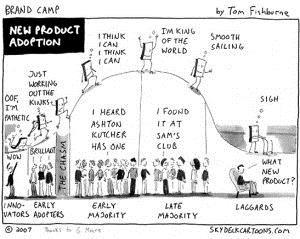In today’s fast paced, ever-changing society, we see many new websites, social media platforms and emerging technologies come into our daily lives.
What makes these new innovations “stick” and become part of our everyday interactions? Why do so many internet startups fail and what make some go viral to become multi-million dollar corporations? On a personal level, how adaptive are you to these emerging social changes? Are you one of the first to subscribe or do you wait around until the change no longer is optional but mandatory to adopt?
These questions can be answered using Everett Roger’s “Diffusion of Innovation.” First, let’s take a look at what makes a new innovation popular and successful.
According to Everett Roger, the key to successful adoption of innovation can be summed up in five characteristics:
1. Relative advantage: Are there any advantages or is there a need for the innovation? The answer varies among the demographic of people that the innovation would serve. If the people have a great need and desire for something, it will be widely adopted.
2. Compatibility with existing values and practices: Does the innovation align with the values, beliefs and common practices of the people it would benefit? The change must go along with one’s personal values.
If one values time and family, for instance, a time saving technology that can be used to promote more family time would be widely accepted. On the other hand, a technology that allows more work to be done at home would interfere with family time and therefore, would not be widely adopted in this demographic due to the values of the people.
3. Simplicity and ease of use: Can this innovation be implemented into one’s daily routine with ease and comfort? Does one have to “re-learn” how to do something that they have always done? Most would agree that if an innovation is easy to understand it would be easily adapted in lieu of an approach that would require one to learn new and more complex skills.
4. Trialability: Has this innovation been tried and tested to work effectively and efficiently? If an innovation has not gone through rigorous trials, it may fail due to the majority of people not wanting to adopt a “sketchy” innovation.
If experiments and testing is completed during a trial stage of an innovation and is found to have all the “kinks” worked out, it will be easily adopted.
5. Observable results: What are the results of the new innovation? Can these results be measured? Is the claim made by the innovation found to be true? Most people will adopt a new innovation if they see that it works and often rely on the measurements of the innovations success as to whether or not they adopt it.
These characteristics offer a valuable evaluation tool to measure the potential of an innovation to catch on in today’s society. If there is an innovation in your profession, the answers to these five questions will determine its success.

In further discussion of diffusion of innovation, Rogers lists five segments of people based on their ability to adopt new innovations:
1. Innovators (2.5 percent): This group is comprised of visionaries, inventors and imaginative, creative minds.
2. Early Adopters (13.5 percent): This group looks out for new ideas that meet their needs. They are quick to adopt change and crave the attention from their peers for having the newest and latest technologies, fashion and other material items.
3. Early Majority (34 percent): This group of people wait until the innovation has measured results. They are looking for a guaranteed approach. They do not want to be left behind by their personal and professional peers.
4. Late Majority (34 percent): This group does not take risks. They are not persuaded by their peers, but rather persuaded by fear and uncertainty that comes with the innovation.
5. Laggards (16 percent): This group holds out to the bitter end. This group will not adopt an innovation unless it becomes absolutely necessary or mandatory.
Where do you fit in when it comes to accepting innovation? More importantly, where does your office or government agency fit in these segments of people? It is a question for us to ponder. . . Are you on board or are you getting left behind?
Emily Arnold is part of the GovLoop Featured Blogger program, where we feature blog posts by government voices from all across the country (and world!). To see more Featured Blogger posts, click here.





Leave a Reply
You must be logged in to post a comment.